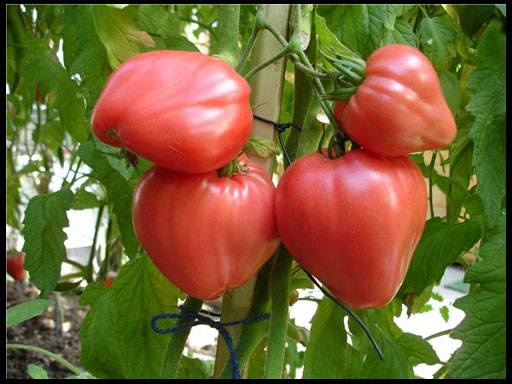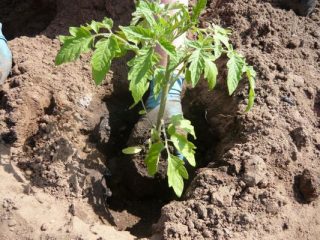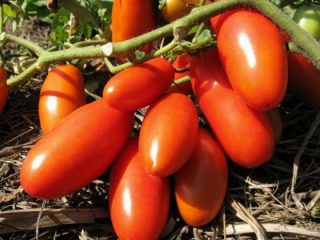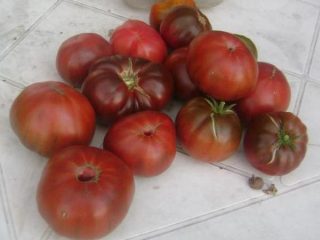Content
When choosing varieties tomatoes for open beds, it is necessary to pay attention not only to their early ripening, but also to cold resistance, bush height and taste. The concept of “taste” includes such a parameter as “sugar content”, which is applied to tomatoes in the same sense as to watermelons. The color, shape and size of tomatoes is determined by the preferences of tomato growers.
With rare exceptions, early ripening and ultra-early tomato varieties are determinant and very often standard.
Standard determinants require minimal care, do not require pinching, but they need to be tied to a support, since with a high yield and large tomatoes, the plants can break under the weight of tomatoes filled with juice.
In the southern regions standard tomatoes They are always planted in open ground, since of all the early varieties of tomatoes they have the highest cold resistance. In cold areas they can be grown in greenhouses.
It should be taken into account that the yield of tomato bushes in open ground lower than in greenhouses.
Just like other tomatoes, early ripening varieties of tomatoes They begin to plant seedlings at the end of March. But what to do if there is no room on the windowsill in the apartment for many seedling containers, and each type of vegetable requires its own germination regime. It is not always possible for a gardener to provide specific conditions for each vegetable.
With early-ripening tomatoes, there is the option of sowing without seedlings, but only if there is a cold film greenhouse.
In such a greenhouse, beds are prepared in advance at the end of March and arcs are placed over them, which are covered with non-woven material. For some time, the soil under the arcs warms up. In the second half of April, tomato seeds are planted in the beds and each hole is covered with a plastic bottle with the bottom cut off.
Before germination, the seeds are protected from the cold by three layers of insulating materials. After emergence, the bottles are removed, leaving non-woven material on the arcs and plastic film on the greenhouse itself. Depending on the ambient temperature, the temperature for seedlings can be adjusted by removing or throwing material over the arches.
With the onset of warm days, if possible, the film can be removed from the frame of the greenhouse itself, leaving the tomatoes to grow in the open air.
When choosing early-ripening tomato varieties for open ground, you should definitely pay attention to the completely unique ultra-early variety, bred in Transnistria, “Riddle”.
Ultra-early tomato varieties
Tomato "Riddle"
Determinant low-growing variety with a powerful trunk. The height of the bush is half a meter. According to reviews from gardeners, it ranks first among ultra-early ripening tomato varieties. No more than 90 days pass from the moment of sowing the seeds to harvesting. With an average density of 7 bushes per meter per unit area, you can get 20 kg of tomatoes.
Tomatoes and bushes grow surprisingly even in size. If the height of the bushes is about 0.5 m, then the weight of tomatoes of this variety is up to 100 g.
The pulp of the fruit is dense, which allows you to bring the tomatoes home safe and sound not only in a box, but also in a regular bag. Also, tomatoes of this variety have the best taste, being a record holder among early tomato varieties for this parameter. Usually early varieties of tomatoes cannot boast of a wonderful taste, being more suitable for canning and culinary processing, which enhance the taste of tomatoes.
Tomato bushes “Riddles” with a large number of leaves do not need tying up, having very strong branches. But the variety has a drawback: a very large number of stepsons that need to be removed in time so that they do not take away nutrition from the ovaries. If the shoots are not removed, the tomatoes will turn out small.
But you can increase the number of bushes of this variety by rooting the removed stepsons. In “Riddle” the stepsons take root very easily.In this case, it will be possible to get a harvest from the stepchildren a week and a half later than the mother bush, thus extending the fruiting period of the variety.
Tomato "Snegirek"
Not only an ultra-early, but also an ultra-determinate variety for open ground, capable of growing not only in the garden, but also on the balcony.
The height of the bush is no more than 0.4 m. standard plant, does not need a garter, does not require pinching. Vegetation period 95 days. One of the advantages is a friendly return of the harvest.
Despite the small size of the bush, the fruits are quite decent in size and weigh on average 150 g. The purpose of the variety is universal.
Tomato "Katyusha"
A relatively new variety, bred in 2001 and finding its fans. Grows well in open-air garden beds. The variety is ultra-early, requiring 85 days before harvesting the first tomatoes.
Among its determinate comrades, this is a fairly tall variety, growing up to 90 cm. One plant produces 5 kg of tomatoes. There should not be more than 5 bushes of this variety per square meter.
Tomato pulp has good taste. The shape is spherical, slightly flattened. The usual weight is about 125 g. First-stage tomatoes can grow up to 150 g. Ripe fruits are pink. The variety is universal. Often used for canning and barrel pickling.
The advantages of the variety are: good taste, high shelf life, resistance to sudden changes in temperature, immunity to many diseases, drought resistance.
The disadvantages are the high demands on agricultural technology. If not properly cared for, it loses its taste.It requires a mandatory garter, since due to the relatively high height of the bush and the large number of fairly large tomatoes, the branches break off. In this regard, “Katyusha” loses to “Riddle”. Demanding on fertilizers.
Features of agricultural technology
In open ground, the variety is best grown in the southern regions. To the north it grows well in greenhouses. The difference in growing conditions does not affect the yield.
Despite its resistance to diseases, the variety is susceptible to phomosis and dry spotting.
Tomato "Bullfinch"
An ultra-early variety bred specifically for cold regions. They are grown outdoors and in greenhouses. The bush is not standard, with limited growth. It grows no more than 40 cm. Thanks to its small growth, it can be grown on balconies. No formation required.
The ovaries are formed in clusters of 3-5 pieces. The weight of ripe tomatoes is 140 g. Ripe, thick red. The pulp is juicy, dense, the taste is sweetish.
The advantages of the variety are drought and cold resistance, high immunity to diseases, and low maintenance requirements.
Young tomatoes are planted in the beds by the beginning of June.
Early ripening varieties of tomatoes
Tomato "White filling"
Low-growing, no more than 50 cm in open ground, not a standard variety. The plant is determinate. Developed in the Kazakh SSR and loved by several generations of gardeners. It was registered in the State Register 50 years ago.
Early variety. Depending on weather conditions, no more than a hundred days pass before the first tomatoes ripen.The variety does not require staking or pinching.
The tomatoes are spherical, medium in size, weigh 100 g. Ripe tomatoes are red, but the variety got its name because of the color of the fruit during ripening. Initially, the tomatoes are light green in color; as they ripen, they become lighter in color, beginning to resemble the “White Fill” variety of apples in color.
The initial purpose of selection when breeding this variety was to process the harvest into tomato products, but it turned out that this variety tastes quite good even in its fresh form. However, it makes excellent ketchup, tomato paste and juice. Although the juice will be a little thick.
The advantages of the variety, carried through time, are: unpretentiousness to weather and care, early ripening and friendly yield, good taste, resistance to cracking on the bush and during conservation.
Disadvantages appeared after the development of new, more productive varieties. Today, these include average yield (3 kg per bush) and average resistance to diseases.
The variety is predisposed to late blight, which does not have time to reach it, since the crop ripens earlier. At the same time, it is immune to macrosporiosis.
Features of agricultural technology
Since “White filling” is a variety and you can get seeds from it, before planting the seeds must be treated with disinfectants.
The ideal place to grow the variety is Kazakhstan, but “White Pouring” also grows well in Ukraine and in the southern regions of Russia.
Tomato "Korneevsky Red"
Early ripening indeterminate tomato.The bush is powerful, densely leafy, up to 1.5 m high. Up to 6 kg of tomatoes are harvested from one bush. Tomatoes are tied in small clusters of 3-4 fruits each.
It is large-fruited, so the bush requires tying to a strong support. The weight of tomatoes starts from 0.5 kg. Tomatoes on the lower branches can grow up to 1 kg.
The fruits are round, with a thick, glossy skin. When ripe, rich red in color. The pulp is fleshy, moderately dense, sweetish in taste.
The purpose is universal. Recommended for both private household plots and farms.
Tomato "Fatima"
Large-fruited variety of determinate type. The height of the bushes is up to 60 cm. It is not standard. Needs a garter, but does not require pinching. Can be grown in all regions of the Russian Federation.
“Fatima” is an early variety with a vegetative period of 85 days, growing well in the open air. "Fatima F1" is a mid-early hybrid for greenhouse conditions. Both varieties are resistant to diseases, not susceptible to late blight and show high yields.
"Fatima" are pink heart-shaped tomatoes with an average weight of 350 g. The fleshy pulp has a pleasant sweetish taste. Tomatoes are resistant to cracking.
The purpose is universal.
A few tips that can help you get an early and rich harvest
Copper wire against late blight
The scourge of many garden crops is late blight, due to which the entire crop can be lost on the vine. As a preventive measure, piercing the lower part of the stem with copper wire is used. The copper is left in the stem.
Copper against late blight:
All foreign particles, such as insulation residues, oxides, and lubricating oil must be cleaned off.
Copper particles will be picked up by the juices and spread throughout the entire tomato bush, but fungi do not like copper.
It should be borne in mind that this is only one of the methods of protection used in a complex. Tomato bushes need to be at least covered from rain and cold dew, not relying on copper wire alone.
There is one more point. Copper will accumulate in tomatoes. True, it is unlikely that it will be able to accumulate in quantities harmful to the body. Copper as a microelement is necessary for humans, and fertilizers containing copper increase plant productivity.
How to speed up the ripening of tomatoes
Accelerating the ripening of tomatoes on the bush instead of ripening green fruits is especially important for fairly cold regions, for example, the Urals. The basic principle underlying all these methods is to limit the supply of nutrients from the soil in order to force the plants to fight for survival and begin to “work for seeds.”
First of all, stop fertilizing the bushes and stop abundant watering. The lower leaves are torn off completely so that the nutrition goes to the fruits and not to the foliage.
There are five mechanical methods to speed up tomato ripening, applied to tomatoes growing in unprotected soil.
- In low-growing bushes, the branches are turned towards the sun and secured with spacers. Spacers are placed under the fruit clusters.
- The tops of the bushes are pinched, leaving only the clusters with ovaries. Two leaves are left above the clusters to ensure fruit growth.
- Plants are sprayed with iodine solution at the rate of 35 drops of iodine per 10 liters of water for one and a half linear meters of beds.
- Low and medium-growing determinate bushes can grow a maximum of 4-5 clusters, so all excess inflorescences are mercilessly broken out.
- At the end of summer, when the tomatoes have already grown and entered the ripening stage, one of the following actions is carried out:
- holding the tomato bush by the lower part of the stem, pull it up a little several times. At the same time, the stem is twisted in a spiral;
- in the lower part of the stem at a distance of 100-120 mm from the ground, a slit 70-100 mm long is cut with a sharp knife. To prevent the gap from closing, it is necessary to place a sliver of 5 mm in diameter into it;
- Thin copper wire is tightened on the stem 30-40 mm from the ground, wrapping it around the stem several times.
Conclusion
Usually early ripening tomato varieties are not able to shock you with their unique taste, but they can be used to make excellent homemade ketchup and mild adjika.
And of course, early tomatoes can be used in vitamin-rich fresh vegetable salads.

















